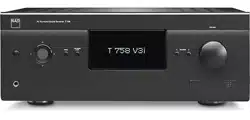Loading ...
Loading ...
Loading ...

ENGLISH
20
SPEAKER SETUP
After connecting all ancillary sources and other combinations, the Speaker
Setup menu will guide you on how to manage and setup your speakers in
order to achieve optimum sound acoustics in your listening environment.
The following are the Speaker Setup Menu sections.
SPEAKER CONFIGURATION
Every surround-sound system requires “bass-management” to direct low-
frequency content from any or all channels to the speakers best able to
reproduce it. For this function to operate correctly, it is important that you
correctly identify your speakers’ capabilities. We use the terms “Small” and
“Large” (and “O”) but note that physical size may be irrelevant.
• A “Small” speaker is any model, regardless of physical size, that lacks
signicant deep-bass response, that is, below about 200 Hz.
• A “Large” speaker is any full-range model; that is, one with deep-bass
response
• An “O” speaker is one that is not present in your system. For example,
you might not have any surround-back speakers installed; in that case,
you would set the “Back” setup item to “O”. For “Height” speakers,
selecting “O” option for “Height 1” will automatically cut o both
Height 1 and Height 2 Audio output.
The Speaker Conguration is “global”; that is, it remains in force with all inputs
and in all listening modes. However, speaker settings are part of the T 758’s
Preset system. Consequently, multiple speaker settings can be stored for easy
recall as dierent types of recordings or listening modes require.
Speaker Conguration can be managed and adjusted by pressing a
combination of [ S ] and then [ D/F] keys. Set “Front”, “Center” and
“Surround” to “Large”, “Small” or “O” as your subsystem’s speakers require.
The “Back” speakers can either be one or two speakers. Set “Back” to either 1 or 2
speakers as per availability. Set “Subwoofer” to “On” or “O,” selecting “On” only if
you have a subwoofer connected to the T 758’s SUBW output jack.
HEIGHT 1/HEIGHT 2
“Height 1” and “Height 2” AUDIO PRE-OUT can be connected to the audio
input of an external power amplier hooked up with up to 4 Height
speakers. Height1/Height 2 settings must be set to “On” at the “Speaker
Conguration” menu to power up the additional Height speakers.
ENHANCED BASS
When the subwoofer is set to ON and “Front” is set to “Large”, Enhanced
Bass is also available. Normally, with speakers set to “Large” the subwoofer
is not active. The Enhanced Bass option allows full range operation of
the speakers with the additional bass contribution of the subwoofer. This
feature is particularly useful when one wants to experience maximum
bass output. Please note that due to acoustic cancellation eects, the bass
response may be uneven when using this setting
You can set Subwoofer to “On” even with “Large” front speakers, in which
case bass content from any channels set to “Small” will be routed to both
the subwoofer and to the front speakers; LFE-channel signal will pass only
to the sub. In most subwoofer-equipped systems, setting front speakers to
“Small” is usually the better option.
All the speakers’ low frequency content can be directly adjusted within the
range 40Hz to 200Hz.
NOTE
The congurations set forth at “Speaker Setup” are carried over
whenever it is enabled during A/V Presets setting. Please see also the
section “A/V Presets” for reference.
SPEAKER LEVELS
Adjusting the relative balance of your system’s loudspeakers ensures that
surround-sound recordings, whether music or lm, will present the balance
of eects, music, and dialog that the artists intended. Additionally, if your
system incorporates a subwoofer, it establishes a correct relationship
between the volume of the subwoofer and the other speakers, and thus of
low-frequencies (bass) to other sonic elements.
USING AN SPL METER
It is quite practical to perform the T 758 level setup routines “by ear,” and
careful work will produce acceptably accurate results. However, the use
of an inexpensive sound-pressure level (SPL) meter, such as Radio Shack
part number 33-2050, makes this task easier, more accurate and more
repeatable. Ownership of such a meter could prove a valuable audio tool.
The SPL meter should be placed at the primary listening position, at
approximately the height of the seated listener’s head. A tripod is helpful
but with a little duct tape almost anything - a pole lamp, music-stand, or
ladder-backed chair, for example - can do as well. Just be sure that no large
acoustically reective surfaces obstruct or are near the microphone element.
Orient the meter with its microphone (usually at one end) pointing straight
up toward the ceiling (not toward the speakers) and ensure that “C”
weighting scale is selected. Set the meter to display 75 dB SPL. On Radio
Shack meters, this necessitates either setting the meter to its 80 dB range
and taking your readings at the -5 point or selecting the 70 dB range and
reading at the +5 point.
OPERATION
USING THE T 758 SETUP MENU
Loading ...
Loading ...
Loading ...
